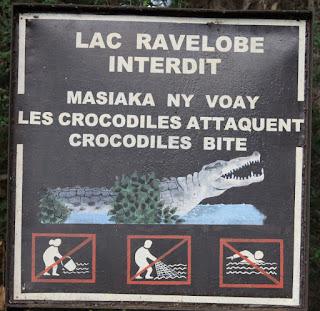 Allan's Gallinule
Allan's Gallinule Allan's Gallinule (detail)
Allan's Gallinule (detail)Thursday 4th - Sunday 7th November 2010
An even earlier flight today, as we left for the airport shortly after 04-00, for the 45 minute trip to Mahajunga on the north west coast and the springboard for the 4 hour drive to Ankarafantsika National Park. The allocation of accommodation here is by no means certain until arrival the 2 options being chalets or tents, personally this made no difference to me whatsoever but we we were all afforded the latter with variable power and water supply. What may be described as a little primitive, these were the type of conditions I had hoped to experience, and with a 3 nights stay there was every chance to do so. With a dozen or more 'endemics' from our veranda alone and a watchtower just 50 feet away the first page of the notebook was filled with little effort, the first new species being Glossy Ibis. However, this was the place where my own personal target was a distinct possibility so I headed straight for the much depleted lake where the search until dark was without success. An organised forest walk had been arranged for 05-00 but again I took a 'rain check' on that and after an hour was rewarded with my first glimpse of an Allan's (otherwise known as Lesser) Gallinule. This species first captured my imagination when Martin Cade, Warden of the Portland Bird Observatory went to investigate a Moorhen found by a lady dog-walker on Portland as this species is extremely rare there. Not as rare however as what Martin found within the cardboard box he was handed on arrival, a moribund Allan's Gallinule. As I understand it, just 12 observers were able to make it the Obs before this dainty little waterfowl expired, and I think it's safe to say it'll be a while before the next is recorded in Great Britain, which neatly leads to the best part of the story. There had only been one previous record in the UK almost exactly 100 years ago, while the man who first described this beautiful creature to science, Captain Allan, was born and died in Weymouth. I hope I have all of these facts correct but if not, just take a look at the images above!
 Coquerel's Sifaka
Coquerel's Sifaka
 Coquerel's Sifaka
Coquerel's Sifaka Ditto
Ditto Ditto (detail)
Ditto (detail) Madagascar Jacana
Madagascar Jacana A slightly better image of Madagascar Squacco Heron
A slightly better image of Madagascar Squacco HeronLakeside People
 A line fisherman
A line fisherman This lady is reaping the roots of Water Hyacinth for both human and livestock consumption.
This lady is reaping the roots of Water Hyacinth for both human and livestock consumption. Water Hyacinth
Water Hyacinth France's Sparrowhawk
France's Sparrowhawk Caterpillar
Caterpillar Cocoon
Cocoon Butterfly
Butterfly Madagascar Paradise Flycatcher (dark morph)
Madagascar Paradise Flycatcher (dark morph) Madagascar Paradise Flycatcher (pale morph)
Madagascar Paradise Flycatcher (pale morph) Forest bloom.
Forest bloom. Red-fronted Coua a shy ground bird.
Red-fronted Coua a shy ground bird. Madagascar Coucal, about the scruffiest one I could find.
Madagascar Coucal, about the scruffiest one I could find. Madagascar Bulbul
Madagascar Bulbul White-headed Vanga
White-headed Vanga Madagascar Lesser Cuckoo
Madagascar Lesser Cuckoo Blue Vanga
Blue Vanga Madagascar Green Pigeon
Madagascar Green Pigeon and under-tail coverts.
and under-tail coverts. Madagascar Turtle Dove
Madagascar Turtle Dove Glossy Ibis
Glossy Ibis
 Sickle-billed Vanga
Sickle-billed Vanga Sickle-billed Vanga copulating
Sickle-billed Vanga copulating

 Madagascar Fish Eagle
Madagascar Fish Eagle Madagascar Fish Eagle (detail)
Madagascar Fish Eagle (detail) Madagascar Fish Eagle nest.
Madagascar Fish Eagle nest. Madagascar Hoopoe foraging
Madagascar Hoopoe foraging finding a juicy spider and
finding a juicy spider and feeding young at the nest hole.
feeding young at the nest hole. Nile Crocodiles, the real thing this time.
Nile Crocodiles, the real thing this time.





 Nile Crocs
Nile Crocs Purple Heron
Purple Heron Purple Heron (detail)
Purple Heron (detail)

 White-breasted Mesite another of the skulking forest ground birds.
White-breasted Mesite another of the skulking forest ground birds.

No comments:
Post a Comment